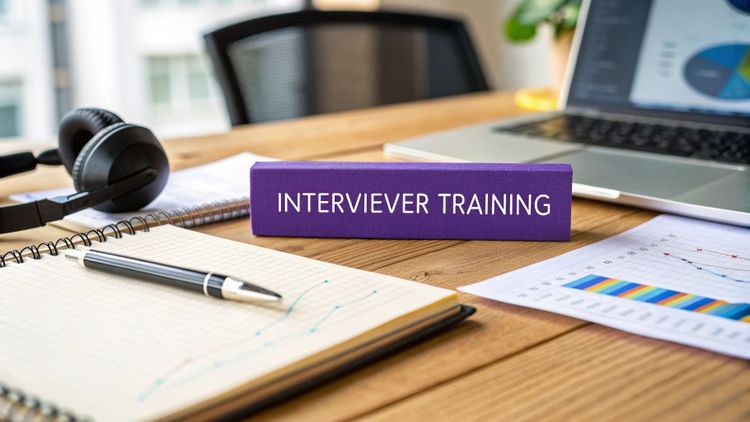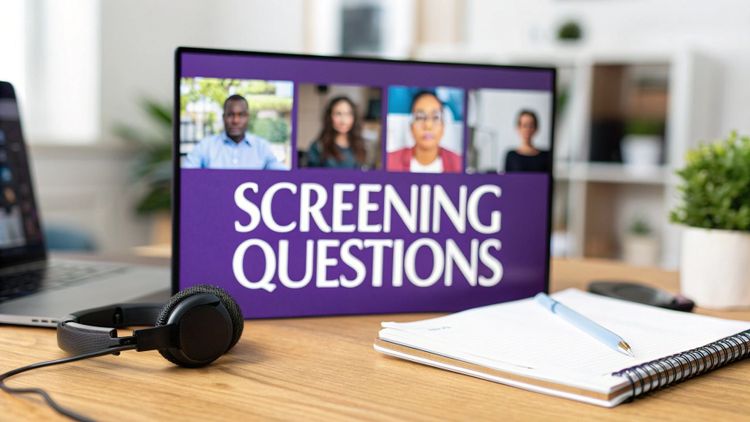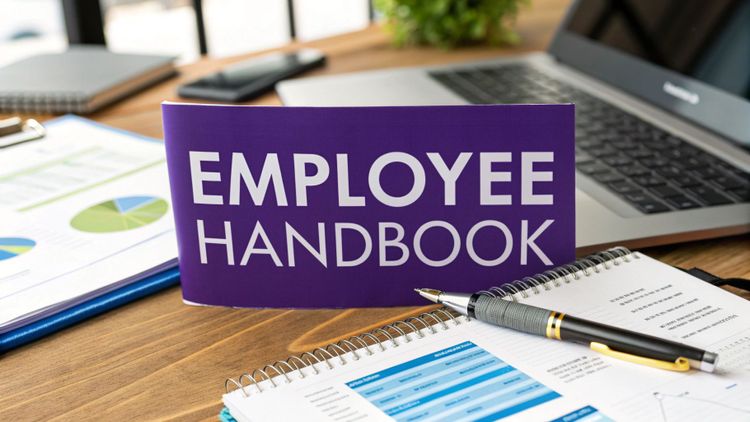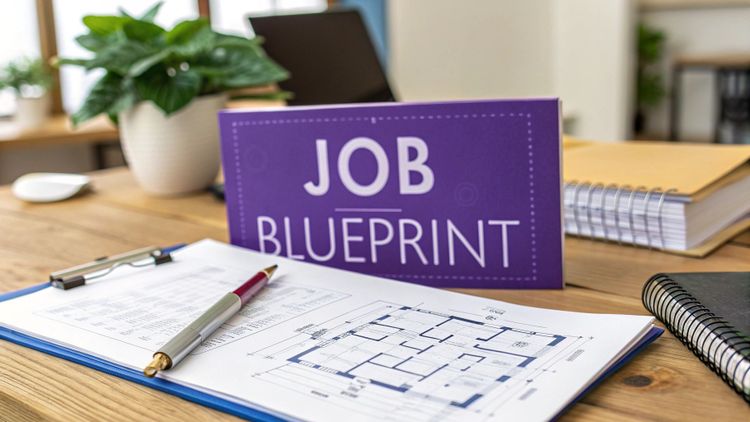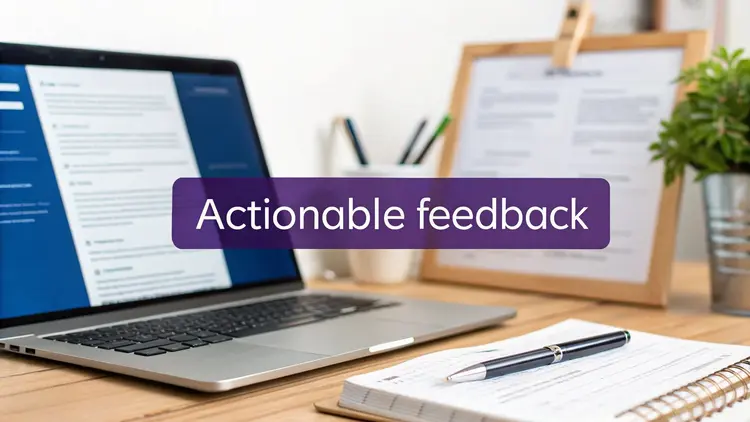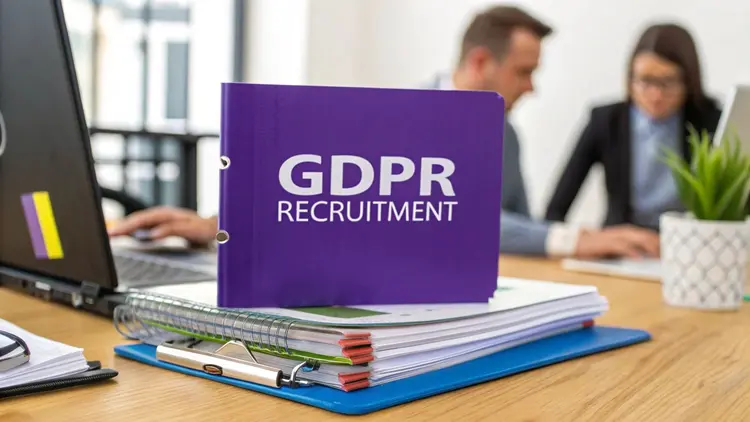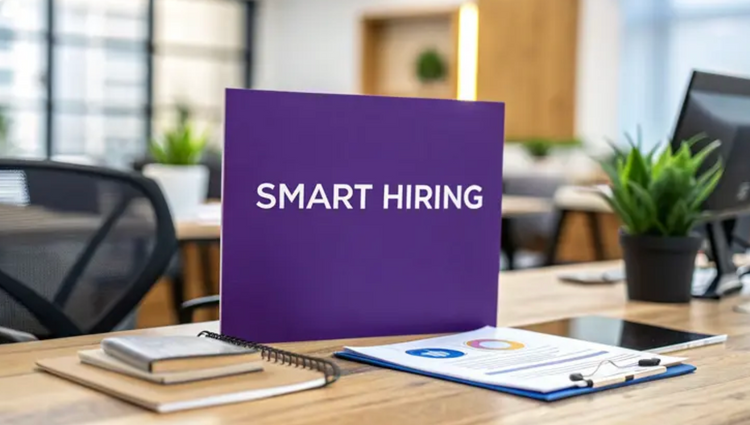HR Processes
Improve Recruitment Process for Lasting Hiring Success

If you aim to genuinely enhance your recruitment process, start by identifying the weak points. This requires an honest evaluation of your current system by mapping every stage, gathering candid feedback, and monitoring the right metrics to identify real bottlenecks. Only then can you implement effective changes that truly make a difference.
Listen to the podcast Here:
Reviewing Your Current Recruitment Workflow
To improve your hiring system, you must first comprehend how the existing one functions—or fails. A comprehensive review isn't merely about checking boxes; it's about establishing a clear baseline to ensure every change is strategic and impactful. It's tempting to jump straight to solutions, but without a proper diagnosis, you risk addressing symptoms rather than the root cause.
The objective is to move beyond assumptions and discover objective evidence. Many organisations believe their main issue is sourcing, only to find that the real problem is a slow interview feedback loop causing top candidates to withdraw.
Map the Candidate Journey From Start to Finish
Begin by visually mapping every step a candidate takes, from seeing your job advert to receiving an offer. What occurs at each stage? Who is responsible? How long does it all take?
This straightforward exercise can be unexpectedly revealing. You might uncover significant inconsistencies you were unaware of. For instance, applications for one department may go directly to the hiring manager, while another department's CVs languish in a general inbox for days, creating a poor first impression.
Gather Honest Feedback (Especially the Tough Stuff)
Data provides part of the story, but the human experience completes it. You need insights from everyone involved in the process to get the full picture.
Hiring Managers: Meet with them to discuss the quality of candidates they encounter. Does the screening process aid or impede them? What support do they need from HR?
New Hires: With the freshest perspective, they can share what they appreciated and what frustrated them during their application journey. Their insights are invaluable.
Rejected Candidates: Though it may feel awkward, a simple, polite survey can provide vital, unfiltered feedback on your company's perception. Many appreciate the opportunity to voice their thoughts.
"The most insightful feedback often comes from candidates who didn't get the job. Their comments are a raw, honest reflection of your employer brand in the real world."
Focus on Key Recruitment Metrics
To ensure your review is genuinely data-driven, concentrate on metrics that measure efficiency and effectiveness. Avoid vanity metrics; focus on numbers that indicate real issues or progress. For example, in early 2024, the average time to hire in the UK decreased from 5.1 weeks to 4.6 weeks, demonstrating that even small process improvements can yield quick results. You can always explore more UK hiring trends to assess your performance.
A thorough audit should start with a selection of crucial KPIs.
Before examining the numbers, it's helpful to have a clear framework. The table below outlines essential metrics to track for an unbiased view of your recruitment performance.
Key Recruitment Metrics for Your Audit
| Metric | What It Measures | UK Benchmark Example |
|---|---|---|
| Time-to-Hire | The total time from a job opening being approved to an offer being accepted. | On average, 29-35 days, but can vary significantly by industry and role complexity. |
| Cost-per-Hire | The total cost of a new hire, including advertising, recruiter time, and agency fees. | The CIPD estimates this to be around £2,000-£5,000 for non-managerial roles. |
| Quality-of-Hire | Often measured through performance reviews or retention rates after 6-12 months. | A common goal is to have 80%+ of new hires meeting or exceeding performance expectations. |
| Source-of-Hire | Identifies which channels deliver your best candidates, helping you focus your budget. | Employee referrals consistently rank as a top source for quality and retention. |
Tracking these metrics allows informed decision-making, guiding your efforts for maximum benefit.
By combining journey mapping, multi-source feedback, and hard data, you'll gain a comprehensive view of your current recruitment landscape. This understanding is not just an exercise; it's the critical first step in a larger strategy to improve your recruitment process in 5 proven steps.
Developing a Proactive Sourcing Strategy

The traditional “post and pray” recruitment model is outdated. Simply advertising a job and hoping the ideal candidate finds it is no longer sufficient. To genuinely enhance your hiring, you must be proactive. This involves actively seeking exceptional talent, building relationships before roles open, and creating a continuous pipeline of qualified individuals.
This shift is increasingly important. As of early 2025, UK job vacancies dropped to 781,000, falling below pre-pandemic levels for the first time. While this may seem advantageous, it actually intensifies the competition for specialised skills, necessitating a more strategic sourcing approach. You can read more about the latest UK vacancy trends on ONS.gov.uk.
A proactive strategy ensures you're never starting from scratch when a position becomes available. It's about developing a sourcing system that consistently attracts both active job seekers and passive talent who may not be looking but would be an excellent fit for your team.
Write Inclusive Job Descriptions That Attract and Convert
Your job description is often the first point of contact a potential candidate has with your company. It should do more than list duties; it must sell the opportunity and speak directly to the kind of person you wish to hire. Many organisations make the mistake of filling adverts with internal jargon or exclusive language that deters talented individuals.
To address this, focus on inclusivity and clear communication.
Scrutinise your language: Avoid gender-coded terms like "dominant" or "ninja." Useful tools can scan your text for biased language. Replace them with neutral alternatives such as "skilled" or "expert."
Focus on outcomes, not just tasks: Instead of listing responsibilities, describe what success in the role looks like. For example, "You'll drive customer retention by developing engaging community initiatives" is more compelling than "Responsible for managing social media."
Separate needs from wants: Be clear about essential skills versus nice-to-haves. Long requirement lists often deter qualified individuals—especially women and those from underrepresented groups—who may not apply unless they meet 100% of the criteria.
Getting this right not only attracts a diverse talent pool but also improves your adverts' ranking on job boards.
Enhance Your Employee Referral Programme
Your current team is one of your most effective—and often overlooked—sourcing channels. They understand the culture and know people in their network who would thrive in it. A well-organised referral programme does more than fill roles; it boosts retention and reduces hiring costs.
However, a simple cash bonus may not be enough to engage employees.
An effective referral programme extends beyond cash incentives. It's about cultivating a culture where your team is proud to recommend their workplace and has straightforward tools to do so.
Consider offering tiered rewards, public recognition for successful referrals, or even granting extra paid time off. The key is to make the process seamless. Provide employees with pre-written, shareable posts for social media and an easy-to-use portal for submitting names. The less friction, the more they will participate.
Build Talent Pipelines in Niche Communities
The perfect candidate for your specialist role likely isn't browsing major job boards. They're more often found in niche online communities, professional forums, or specialised LinkedIn groups. This is where proactive sourcing excels.
Rather than merely posting a job link, become an active member of these communities. Engage in discussions, share useful insights, and build a reputation as a knowledgeable expert in your field. This isn't about spamming your vacancies; it's about forging genuine connections.
When a relevant role opens, you'll have a warm audience and a network of potential candidates who already know, like, and respect your organisation. It's a long-term strategy, but the quality of hires it yields is significant. To manage these efforts efficiently, you can explore our guide on recruitment automation software tools to see how technology can simplify your outreach.
Modernising Your Screening and Interview Process
Once you have a steady flow of applicants, the next challenge is identifying the best candidates efficiently and fairly. This stage is often where recruitment processes falter. Top candidates can be lost to slow, biased, or inconsistent evaluation methods. To build a team that can truly advance your business, you need to modernise your screening and interviewing approach.
The key is to move from subjective "gut feelings" to objective, evidence-based decisions. This isn't about eliminating the human element from hiring. It's about structuring it to minimise unconscious bias and focus on what actually predicts success in the role. A well-calibrated process ensures confidence in every new hire.
Optimising Screening with Your ATS
Your Applicant Tracking System (ATS) should do more than just act as a digital CV storage. When configured properly, it can significantly assist in managing high application volumes without compromising quality. Conversely, a poorly set-up ATS can be a liability, potentially dismissing excellent candidates due to unconventional backgrounds or non-standard CV formats.
To optimise this, consider strategic keyword use rather than rigid rules. For instance, instead of a strict "knockout" criterion that rejects anyone lacking a specific degree, implement a scoring system. Emphasise keywords related to core skills while allowing profiles with related or transferable experience to pass for human review. It's a balancing act that prevents missing out on hidden gems capable of performing the role.
In the UK's competitive job market, this level of efficiency is essential. Only about 2% of applicants make it to an interview, with hiring managers typically seeing around six candidates per role. Your screening process must be both swift and precise. A well-designed ATS is invaluable here. You can discover more UK job interview statistics to compare your own process.
This infographic illustrates how different screening methods impact candidate progression, highlighting the benefits of incorporating skills-based tests alongside traditional CV reviews.
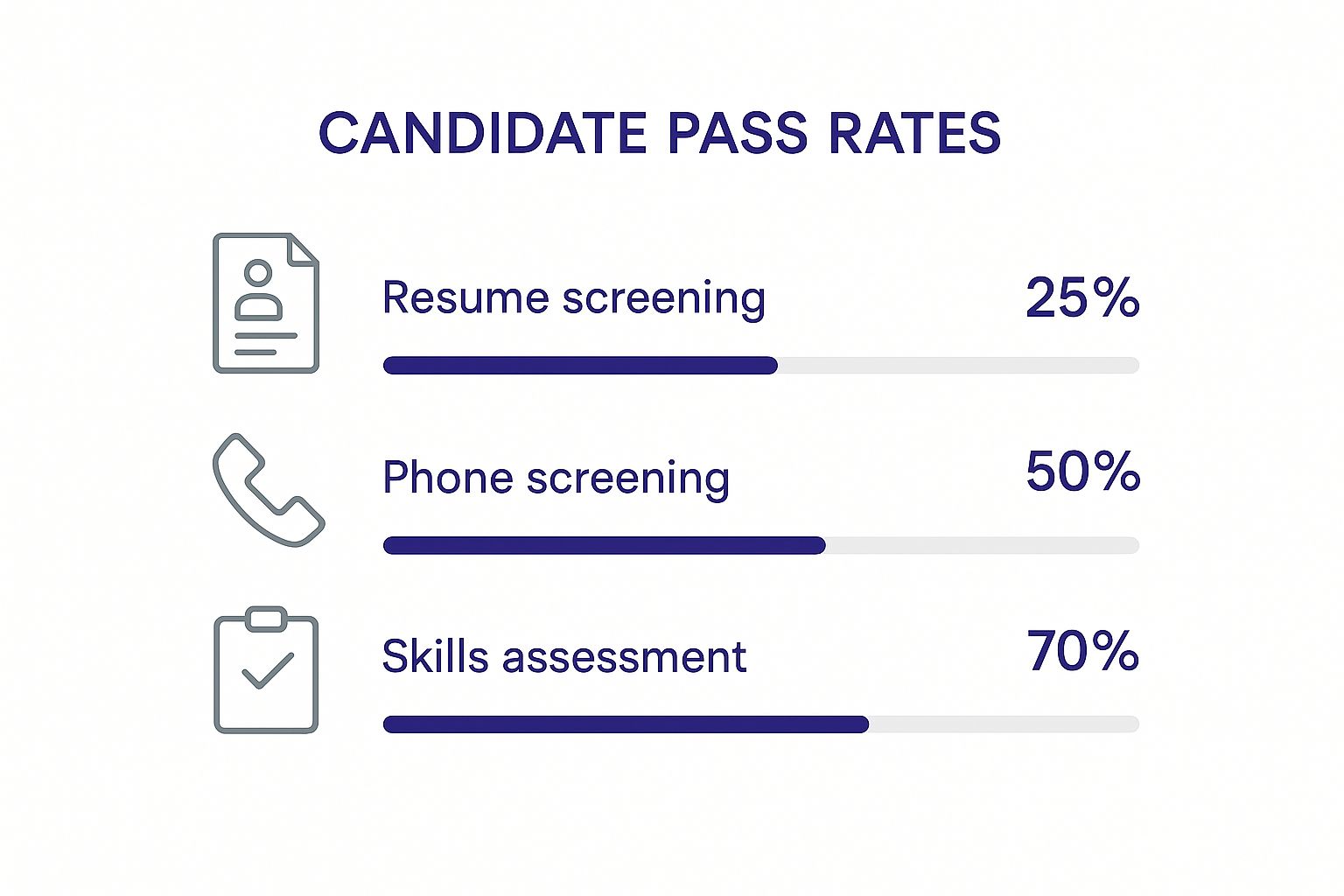
As shown, integrating skills-based tests significantly enhances your ability to advance suitably qualified candidates compared to merely reviewing CVs.
Designing Bias-Reducing Structured Interviews
Implementing structured interviews can have a substantial impact on your hiring outcomes. Avoid those unstructured, free-flowing conversations where questions vary for each candidate. A structured approach offers the necessary fairness and consistency.
The process is straightforward: every candidate for the same role answers the same set of pre-planned questions, in the same order. Their responses are then evaluated against a pre-defined scoring rubric. This ensures candidates are assessed based on the substance of their answers, aligning their skills with job criteria, rather than on less tangible factors like rapport or shared interests.
"A structured interview isn't about being robotic; it's about fairness. It provides a level playing field where every candidate has an equal opportunity to demonstrate their competence, free from the interviewer's unconscious biases."
This method is consistently shown to be a better predictor of job performance. It also helps build a more diverse team by addressing "like-me" bias—managers' unconscious preference for candidates who resemble themselves.
Let's compare the two approaches.
Structured vs Unstructured Interviews
The contrast between a casual conversation and a structured interview is significant. One relies on gut feeling, while the other is based on evidence. Here's a quick comparison highlighting why a structured approach is more effective for making successful hires.
| Feature | Unstructured Interview | Structured Interview |
|---|---|---|
| Questions | Spontaneous, varies by candidate. Often focuses on rapport. | Predetermined, job-related questions asked to all candidates. |
| Evaluation | Based on "gut feeling" or overall impression. Highly subjective. | Uses a scoring rubric to rate answers against set criteria. Objective. |
| Consistency | Low. Different candidates have vastly different experiences. | High. Ensures every candidate is assessed on the same basis. |
| Bias Risk | High. Prone to unconscious, similarity, and confirmation biases. | Low. The structured format actively reduces the impact of bias. |
| Predictive Value | Low. Poor predictor of future job performance. | High. A much stronger predictor of success in the role. |
Transitioning to structured interviews provides a consistent, defensible process that helps you identify the best candidate for the role, not just the one you liked most.
Incorporating Relevant Skills Assessments
While interviews are excellent for evaluating communication skills and behavioural traits, skills assessments offer concrete proof of a candidate's technical abilities. These are especially useful for roles requiring specific skills, like software development, data analysis, or graphic design.
The key is to ensure the assessment is job-relevant and respectful of the candidate's time.
Tailor the Task: The test should reflect a real-world problem they'd encounter in the role. Generic, off-the-shelf quizzes are less insightful than small, role-specific projects.
Set Clear Expectations: Clearly communicate how long the task should take and how it will be evaluated. Requesting a three-hour coding challenge in the initial stage is often unreasonable.
Provide Feedback: Whenever possible, offer brief feedback on their assessment. Even if you decide not to proceed with them, this respectful gesture can significantly enhance your employer brand.
By combining an optimised ATS, structured interviews, and relevant skills assessments, you create a robust, multi-faceted evaluation process. This approach enables you to look beyond superficial impressions and confidently identify the right individual for your team.
Crafting an Unforgettable Candidate Experience

Your recruitment process extends beyond a series of steps; it's a reflection of your company culture and values. Every applicant, regardless of whether they secure the role, leaves with a lasting impression of your brand.
A negative experience can deter talented individuals and damage your reputation. However, a positive experience can create lifelong advocates. Research indicates that 83% of candidates have encountered a poor experience during recruitment, highlighting a significant opportunity for companies willing to invest in improvement.
This isn't merely about politeness. Recruitment is a two-way street; candidates evaluate you as much as you assess them. The advantage? Creating a positive journey doesn't require a large budget. It centres on clear, consistent, and timely communication at every touchpoint.
Prioritise Proactive and Transparent Communication
We've all heard the horror stories about the application "black hole." Candidates invest hours in an application, submit it, and then hear nothing. This is a major source of frustration in recruitment.
The simplest way to enhance your recruitment process is to bridge this communication gap. Your ATS should automatically send a confirmation email once an application is received. This small, automated step reassures candidates that their effort hasn't been wasted.
From there, it's about managing expectations. Be transparent about the general timeline and strive to adhere to it. If delays occur—and they often do—don't remain silent. A brief, honest update can work wonders. A simple note like, "We've encountered scheduling conflicts, but we're still very interested and will be in touch by the end of next week," shows respect and keeps top candidates engaged.
"Ghosting candidates is the fastest way to erode your employer brand. Even a templated rejection email is better than silence. A respectful 'no' protects your reputation and keeps the door open for future opportunities."
Transform Onboarding from a Task to a Strategy
The candidate experience doesn't end with the offer letter. In fact, this is where many companies falter. A cumbersome, paperwork-heavy initial period can quickly dampen the excitement of a new job. Onboarding should be a strategic programme designed to integrate new hires, not just an admin checklist.
This process should begin as soon as they accept the offer.
Pre-boarding: Send a welcome kit with company merchandise. Share a casual welcome video from the team or a clear agenda for their first week. These gestures foster a sense of belonging before day one.
The First Day: Ensure their laptop, accounts, and workspace are ready. Nothing signals "we weren't ready for you" like a new starter waiting for IT.
Assign a Buddy: Pair them with a friendly colleague who can guide them, answer questions, and make introductions. This greatly aids in making them feel at home.
A well-structured onboarding process demonstrates your organisation's professionalism and genuine investment in their success.
A Roadmap for the First 90 Days
To truly set someone up for success, you need a plan extending beyond the first week. The first three months are critical for a new hire. It's when they decide if they've made the right choice and when they start becoming an engaged, productive team member.
A solid 90-day plan should be built around three pillars:
Setting Clear Goals: Collaborate with their manager to define success at the 30, 60, and 90-day marks. This provides clear direction and enables them to make an early impact.
Fostering Connections: Schedule introductory meetings with key people in other departments. This helps them understand the bigger picture and build the internal network needed to succeed.
Creating Feedback Loops: Set up regular, informal check-ins with their manager and someone from HR. These are crucial for addressing questions, raising concerns, and ensuring they feel supported.
By focusing on these elements, you craft a journey that feels thoughtful and professional from the first click to their three-month anniversary. For a deeper look, you can explore our complete guide on how to create an outstanding candidate experience.
Using Data to Continuously Improve Recruitment
To truly understand your recruitment process, you must stop guessing and start measuring. Thinking like an analyst is no longer optional; it's essential for driving real, continuous improvement and demonstrating the value of your hiring efforts.
Without data, you're operating blind, relying on gut feelings that can be wildly inaccurate and costly. Data provides the hard evidence needed to identify what's working, what's broken, and where to focus your resources for the greatest returns. It transforms recruitment from a reactive chore into a strategic business driver.
Identifying Your Most Important KPIs
You can't improve what you don't measure. The first step is identifying the key performance indicators (KPIs) that tell the most critical story about your hiring success. Being overwhelmed with data is as unhelpful as having none, so focus on metrics that directly align with business priorities.
Here are the essential KPIs to track:
Quality-of-Hire: The ultimate measure of success. Typically tracked through first-year performance reviews, manager satisfaction surveys, or retention rates after 12 months. A high quality-of-hire indicates your process identifies individuals who truly thrive in your company.
Source-of-Hire Effectiveness: Where do your best people really come from? Tracking this might reveal that while a major job board generates many applications, your employee referral programme delivers candidates who are hired faster and stay longer. This data guides your sourcing budget allocation.
Time-to-Fill: The time from job approval to offer acceptance. A long time-to-fill not only looks bad but also means losing great candidates to competitors and leaving teams understaffed. Monitoring this helps identify process bottlenecks.
Offer Acceptance Rate: The ratio of offers accepted to offers made is a powerful indicator of your candidate experience and compensation strategy's health. A low acceptance rate signals a serious issue at the final stage.
Tracking these metrics is more than just numbers on a spreadsheet. It's about building a solid business case for change, whether that's investing in new tools, justifying a larger budget, or refining your interview techniques.
Building Actionable Recruitment Dashboards
Once you know what to track, you need an intuitive way to interpret the data. Your Applicant Tracking System (ATS) is the ideal starting point. Many modern systems, like SeeMeHired, offer customisable reporting dashboards to display exactly what you need.
If your ATS reports are limited, a simple spreadsheet can suffice. Keep it visual and focused on trends over time. A good dashboard should allow you to quickly see if your time-to-fill is increasing or if one department has a significantly lower offer acceptance rate than others.
For example, your dashboard might reveal that your time-to-fill consistently exceeds 60 days. That prompts further investigation. Are interviews delayed? Is feedback slow? This data-driven approach turns a vague sense of "hiring feels slow" into a specific issue: "we have a two-week delay at the interview feedback stage." For more insights, learn how to reduce time-to-hire with 8 powerful strategies.
Using Data to Prove ROI and Drive Decisions
Armed with clear data, you can engage leadership in a different kind of discussion. Rather than advocating for a new tool because it "seems better," you can present a strong business case.
Consider this scenario: you notice low quality-of-hire for tech roles and lengthy time-to-fill. But your data shows that candidates from a niche tech job board consistently perform better in interviews.
Now, you can propose targeted investment in that job board, supported by evidence. You can demonstrate that it will likely improve hiring outcomes and reduce the time key roles remain unfilled, saving the company money.
This cycle—measure, analyse, act, and measure again—drives continuous improvement. It ensures every change is a calculated step forward, turning your recruitment function into a refined, evidence-based operation that consistently attracts top talent.
Common Questions on Improving Recruitment
Even with a clear strategy, embarking on a project to improve your recruitment process raises practical questions. Below are common challenges faced by HR professionals and hiring managers as they refine their approach. Consider these quick, actionable insights for obstacles not fully addressed in the sections above.
How Can a Small Business Improve Recruitment Without a Big Budget?
For smaller organisations, flashy tech solutions and expensive job boards may be out of reach. Focus on low-cost, high-impact activities that differentiate you. Your most valuable assets are your unique company culture and the ability to offer a personal touch.
Begin by maximising your employee referral programme. Large cash bonuses may not be necessary. Non-monetary incentives like extra paid time off, public recognition, or desirable tech can be highly effective. This approach consistently yields high-quality candidates already endorsed by trusted team members.
Next, enhance your job descriptions. Move beyond a dry list of duties and craft compelling copy that sells the opportunity. This is your chance to make a personal connection, so highlight your unique culture, work-life balance, and growth potential.
Finally, explore free sourcing channels. These are valuable if you know where to look:
Niche community forums related to your industry.
Professional groups on platforms like LinkedIn.
Local university and college career boards.
Your own company social media channels.
An exceptional candidate experience, driven by personal and timely communication, requires effort but not funding. It builds a powerful reputation that money can't buy.
A thoughtful, well-communicated hiring journey can be a small company's greatest competitive advantage. It demonstrates a level of care and respect that larger, more impersonal organisations often struggle to match.
What Is the Single Most Impactful Change to Reduce Hiring Bias?
Introducing structured interviews is the most effective change you can implement. This adjustment brings a level of objectivity difficult to achieve by other means.
So what does this entail? It means asking every candidate for a specific role the exact same set of predetermined, job-related questions. More importantly, evaluate their answers against a consistent scoring rubric that aligns with the job's core competencies.
This structure compels interviewers to assess candidates on skills and qualifications, not just "gut feelings" or rapport. It systematically removes the influence of unconscious biases, such as affinity bias (favouring similar people) or confirmation bias (seeking evidence to support quick judgments). The result is a fairer process leading to better, more predictive hiring decisions. Learn more with these 9 tips to create a more efficient hiring process, which include structuring interviews effectively.
How Do I Convince Leadership to Invest in Recruitment Technology?
Securing buy-in for new technology, like an Applicant Tracking System (ATS), requires discussing business outcomes, not just HR convenience. Frame your proposal around metrics: efficiency gains, cost savings, and risk reduction.
Start with data from your initial process audit. Quantify inefficiencies. For example, calculate the monthly hours spent manually reviewing CVs and translate that into salary costs. Show the financial impact of inefficient admin.
Highlight the risks of your current system. A poor candidate experience can harm your employer brand, making future talent attraction more challenging. Calculate the cost of a bad hire—often estimated at 30% of the employee's first-year salary—and explain how better screening tools reduce this risk.
Present the ATS as a strategic solution that will:
Reduce time-to-hire, filling revenue-generating or critical roles faster.
Improve quality-of-hire by offering superior screening and assessment tools.
Provide the data needed for strategic workforce planning and proving ROI.
Framed this way, an ATS shifts from an "HR expense" to a smart investment in the company's future success.
Ready to transform your hiring from a manual chore into a strategic advantage? SeeMeHired provides an all-in-one platform to attract, screen, interview, and onboard top talent faster than ever. Book a demo today and see how our user-friendly ATS can help you build the team your business deserves.

